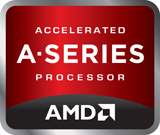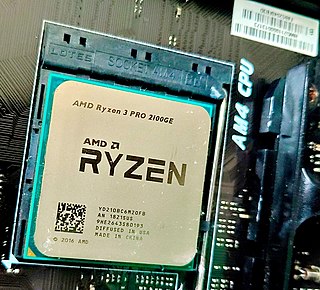Related Research Articles

Advanced Micro Devices, Inc. (AMD) is an American multinational corporation and fabless semiconductor company based in Santa Clara, California, that designs, develops and sells computer processors and related technologies for business and consumer markets.

ATI Technologies Inc., commonly called ATI, was a Canadian semiconductor technology corporation based in Markham, Ontario, that specialized in the development of graphics processing units and chipsets. Founded in 1985, the company listed publicly in 1993 and was acquired by AMD in 2006. As a major fabrication-less or fabless semiconductor company, ATI conducted research and development in-house and outsourced the manufacturing and assembly of its products. With the decline and eventual bankruptcy of 3dfx in 2000, ATI and its chief rival Nvidia emerged as the two dominant players in the graphics processors industry, eventually forcing other manufacturers into niche roles.

Centrino is a brand name of Intel Corporation which represents its Wi-Fi and WiMAX wireless computer networking adapters. Previously the same brand name was used by the company as a platform-marketing initiative. The change of the meaning of the brand name occurred on January 7, 2010. The Centrino was replaced by the Ultrabook.
The AMD Family 10h, or K10, is a microprocessor microarchitecture by AMD based on the K8 microarchitecture. The first third-generation Opteron products for servers were launched on September 10, 2007, with the Phenom processors for desktops following and launching on November 11, 2007 as the immediate successors to the K8 series of processors.
The Radeon Xpress 200 is a computer chipset released by ATI. The chipset supports AMD 64-bit processors as well as supporting Intel Pentium 4, Pentium D and Celeron processors. Additionally, it includes support for DDR400 RAM and DDR-2 667 RAM on the Intel Edition.

AMD Live! is the name of AMD's initiative in 2005 aimed at gathering the support of professional musicians and other media producers behind its hardware products. The primary focus of this initiative was the Opteron server- and workstation-class central processing units (CPUs).

AMD Accelerated Processing Unit (APU), formerly known as Fusion, is a series of 64-bit microprocessors from Advanced Micro Devices (AMD), combining a general-purpose AMD64 central processing unit (CPU) and 3D integrated graphics processing unit (IGPU) on a single die.
The AMD 690 chipset series is an integrated graphics chipset family which was developed and manufactured by AMD subsidiary ATI for both AMD and Intel platforms focusing on both desktop and mobile computing markets. The corresponding chipset for the Intel platform has a marketing name of Radeon Xpress 1200 series.
Unified Video Decoder is the name given to AMD's dedicated video decoding ASIC. There are multiple versions implementing a multitude of video codecs, such as H.264 and VC-1.
The AMD Bobcat Family 14h is a microarchitecture created by AMD for its AMD APUs, aimed at a low-power/low-cost market.

AMD Hybrid Graphics technology, is a collective brand from AMD for its Radeon line of discrete and integrated GPU, promoting higher performance and productivity while saving energy consumption in GPUs.
The HP Pavilion dv2 was a series of 12" notebooks manufactured by Hewlett-Packard Company.
AMD Piledriver Family 15h is a microarchitecture developed by AMD as the second-generation successor to Bulldozer. It targets desktop, mobile and server markets. It is used for the AMD Accelerated Processing Unit, AMD FX, and the Opteron line of processors.
AMD Steamroller Family 15h is a microarchitecture developed by AMD for AMD APUs, which succeeded Piledriver in the beginning of 2014 as the third-generation Bulldozer-based microarchitecture. Steamroller APUs continue to use two-core modules as their predecessors, while aiming at achieving greater levels of parallelism.
Socket AM1 is a socket designed by AMD, launched in April 2014 for desktop SoCs in the value segment. Socket AM1 is intended for a class of CPUs that contain both an integrated GPU and a chipset, essentially forming a complete SoC implementation, and as such has pins for display, PCI Express, SATA, and other I/O interfaces directly in the socket. AMD's first compatible CPUs, designated as APUs, are 4 socketable chips in the Kabini family of the Jaguar microarchitecture, marketed under the Athlon and Sempron names and announced on April 9, 2014. Socket AM1 was initially branded as Socket FS1b before its release.

Zen 2 is a computer processor microarchitecture by AMD. It is the successor of AMD's Zen and Zen+ microarchitectures, and is fabricated on the 7 nm MOSFET node from TSMC. The microarchitecture powers the third generation of Ryzen processors, known as Ryzen 3000 for the mainstream desktop chips, Ryzen 4000U/H and Ryzen 5000U for mobile applications, as Threadripper 3000 for high-end desktop systems, and as Ryzen 4000G for accelerated processing units (APUs). The Ryzen 3000 series CPUs were released on 7 July 2019, while the Zen 2-based Epyc server CPUs were released on 7 August 2019. An additional chip, the Ryzen 9 3950X, was released in November 2019.

Ryzen is a brand of multi-core x86-64 microprocessors designed and marketed by Advanced Micro Devices (AMD) for desktop, mobile, server, and embedded platforms based on the Zen microarchitecture. It consists of central processing units (CPUs) marketed for mainstream, enthusiast, server, and workstation segments and accelerated processing units (APUs) marketed for mainstream and entry-level segments and embedded systems applications.

Zen 3 is the name for a CPU microarchitecture by AMD, released on November 5, 2020. It is the successor to Zen 2 and uses TSMC's 7 nm process for the chiplets and GlobalFoundries's 14 nm process for the I/O die on the server chips and 12 nm for desktop chips. Zen 3 powers Ryzen 5000 mainstream desktop processors and Epyc server processors. Zen 3 is supported on motherboards with 500 series chipsets; 400 series boards also saw support on select B450 / X470 motherboards with certain BIOSes. Zen 3 is the last microarchitecture before AMD switched to DDR5 memory and new sockets, which are AM5 for the desktop "Ryzen" chips alongside SP5 and SP6 for the EPYC server platform and sTRX8. According to AMD, Zen 3 has a 19% higher instructions per cycle (IPC) on average than Zen 2.
References
- ↑ AMD Open Platform Approach from AMD Analyst day presentations, slide 32
- ↑ Retaining the ATI brand from AMD Analyst day presentations, slide 7
- ↑ AMD Financial Analyst Day 2007 presentation Archived July 6, 2008, at the Wayback Machine , presented by Rick Bergman, page 14 of 22. Retrieved December 14, 2007
- ↑ AMD Financial Analyst Day 2007 presentation Archived February 9, 2012, at the Wayback Machine , presented by Mario Rivas, page 7 of 28. Retrieved December 14, 2007
- ↑ Patrick Schmid (27 February 2007). "Dual Core Notebook CPUs Explored". Tom's Hardware. Retrieved 25 April 2023.
- ↑ 2nd Gen AMD Ultrathin Platform
- ↑ "The 2009 AMD Mainstream Platform". Archived from the original on 2012-05-27. Retrieved 2017-08-23.
- ↑ "The 2010 AMD Ultrathin Platform". Archived from the original on 2012-10-31. Retrieved 2017-08-23.
- 1 2 AMD M880G Chipset
- ↑ The 2010 AMD Mainstream Platform
- ↑ AMD Fusion APU Era Begins
- ↑ "AMD Community".
- ↑ "Products. Notebook". amd.com. 2011. Retrieved 25 April 2023.